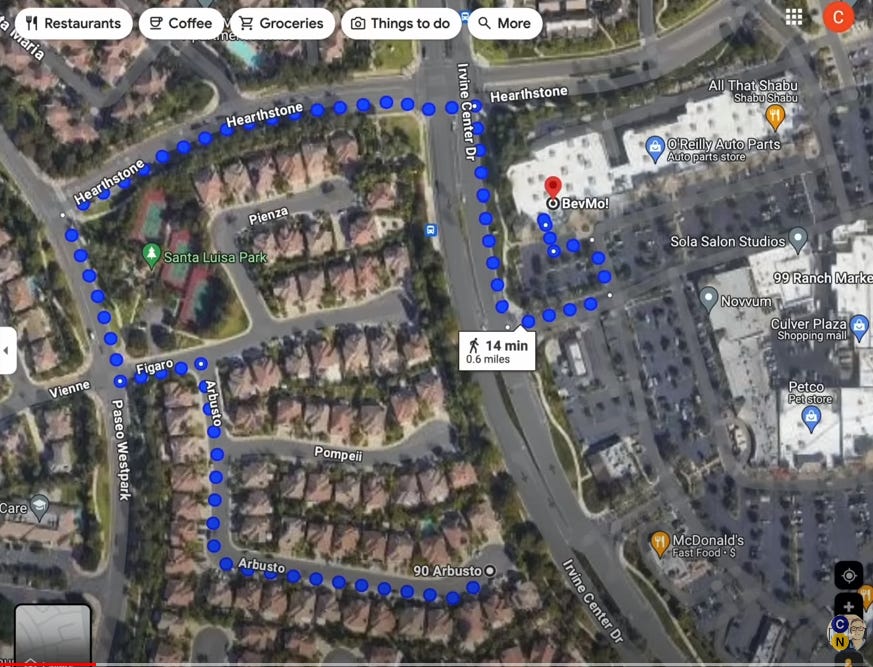Development from the outside in
Can Irvine become a central city?
[Note to readers: I just discovered that Substack has a messaging option. If I didn’t reply to a query during the first 10 days of September, try again. I may have accidentally deleted your message.]
Cities have been around for thousands of years. As far as I know, all cities have developed in essentially the same way---from the inside out. From a small central area, development gradually spreads to more outlying districts. Orange County is an extremely unusual place---a metro area that is developing from the outside in.
Orange County (pop. 3.2 million) is America’s 6th most populous county, and the largest one with no central city. But that’s beginning to change. Until recently, a large area in central Orange County has been largely empty, while suburban development boomed all around it. This land is located in the city of Irvine, which has a (admittedly long shot) chance to become America’s next great city.
I live in nearby Mission Viejo, which has the same population as it had in 2000. During this period, Irvine’s population has more than doubled, and is still growing at a rapid pace. Irvine builds more homes each year than the next 10 Orange County communities combined. The LA Times has a recent article on Irvine:
A net 6,200 people moved into a ZIP Code in northeast Irvine between 2019 and 2022, the most of any in Southern California, according to a Times analysis of U.S. Postal Service data.
Orange County is located on the coast, just south of LA County. (Map at bottom of post.) Not surprisingly, development mostly proceeded from the north to the south, with one exception. During the second half of the 20th century, Orange County’s rapid development largely missed Irvine, and jumped further south to communities like Lake Forest and Mission Viejo. That’s because Irvine’s development was controlled by the Irvine Company, which proceeded at a very methodical rate.
Irvine is not just a bedroom community; the Irvine Company also set aside land for several large business parks. Quite a few companies are headquartered in Irvine, with several clusters of 10 to 15 story office buildings. Orange County’s airport is right on the edge of the city. Irvine has a large, highly rated university. It is now building a massive city park with a new entertainment complex. Someday, the Census Bureau may rename Orange County as “metro Irvine”. (Anaheim still has a larger population, but Irvine will probably pass it soon.)
Irvine is also the most Yimby city in coastal regions of California, by far. And according to the LA Times, it also has the fastest house price appreciation in America. Irvine would be the best example of the hypothesis “building more homes increases home prices”. (Score one for Scott Alexander.) Of course, building more homes doesn’t directly increase home prices. Instead, what’s going on is that the Irvine Company is creating a sort of model city, the kind of place that’s normally only built in booming places like Texas or the Persian Gulf. But with a mild Mediterranean climate.
Again, the LA Times:
Surrounding areas have seen significant price appreciation. Besides Irvine, four other spots in Orange County — Laguna Niguel, Tustin, Lake Forest and Mission Viejo — are in the top 12 of cities nationally with the highest percentage increases in home values over the last year, per Zillow.
Those “four other spots in Orange County” are not just random OC suburbs; they are fairly close to Irvine. That’s one reason why I say Irvine is becoming a sort of central city. Despite much inferior schools, Mission Viejo has become an acceptable alternative to Irvine for people that cannot afford Irvine prices. (Over at Econlog, I have a new post on Laguna Niguel.)
Irvine is both pleasant and boring:
Some residents have described the manicured sameness as stultifying, but the high-quality amenities and lifestyle have garnered deep devotees.
Jonathan Sun, 37, bought a new condo in Irvine in 2017, then married and upgraded to a new four-bedroom home with his wife two years later. He said that the village concept with houses, schools, parks and shops all nearby makes life convenient.
To a recent immigrant from Pakistan or Senegal, Irvine and Mission Viejo would seem quite similar---both have typical California houses and strip malls. But Irvine has a different vibe. Here’s one example. Mission Viejo has slightly older strip malls, with ugly parking lots in front of boring storefronts selling burgers and pizzas. Irvine malls are newer, have more shade in the parking lots, and a mix of tasty Asian, Mexican and Mediterranean restaurants with sidewalk eating out in front on a wide plaza, under shady trellises that protect you from the sun. On a nice day, it feels like paradise. And there are lots of nice days. (Although Irvine food is good, it’s still well below LA and SF quality.)
Here is something I did not know:
Arrays of homeowner associations and special taxing districts oversee the villages, and the Irvine Co. maintains a heavy hand in the city. Three-quarters of the more than 40,000 apartment units in Irvine remain under its ownership, per data from the real estate firm CoStar.
You’d think an affluent city like Irvine would not want any more apartments. But the city has plans to build thousands more in the near future, in 10 different locations. Monopolies like the Irvine Company effectively internalize the externalities of development.
If Orange County were in Europe, Newport Beach would be its central city, as it has a fine harbor. But unlike the twin ports of LA and Long Beach, Newport’s harbor is all pleasure boats. And unlike Irvine, Newport Beach is extremely Nimby. Actually, almost all of OC is Nimby. Next to Irvine, the least bad are places like Anaheim and Santa Ana; heavily Hispanic towns built in the 1950s and 1960s, where new apartment buildings represent a quality upgrade.
The census says that Irvine is 45.5% Asian, but that figure is already out of date, as most of the new homes are being bought by the Chinese. Here’s a typical anecdote:
“You could talk to a Chinese or Korean person and they would know Irvine,” Calcote said. “They may not even know California, but they know Irvine.” [Hyperbole---they know California, but still . . . ]
Foreign buyers, who often pay in cash or borrow outside the traditional mortgage market, aren’t as sensitive to higher rates. These owners may be moving to Irvine or just looking for a safe place to park their money. Orange County is one of the rare spots in the country where investor activity has been accelerating, according to research from Burns’ firm.
Liu Guanyi of Shanghai paid $2 million in June for a new four-bedroom house in Irvine’s Portola Springs community. In the next few years, he plans to move in with his family.
He was already well acquainted with Irvine. In 2019, he and his wife had traveled there for the birth of their first child so she could be a U.S. citizen. Afterward, he bought a house in Irvine, another in Anaheim and the new one is his third in Orange County.
The article says that Liu was motivated by Irvine’s good schools and low crime rate. And when I meet Chinese people in Irvine, I hear the following comments all the time:
The Chinese government’s harsh lockdowns during the pandemic accelerated Liu’s timetable for relocating. He is applying for a green card through the EB-5 immigrant investor program.
Like any central city, Irvine is getting denser. According to the OC Register, Irvine’s city council recently approved a plan to add 23,610 more houses, and also to create denser neighborhoods:
Irvine does not need to build any units, just zone for them, and the council is doing that by opening up certain areas in the general plan for higher density, mixed-use development where housing and retail will be closer together.
I find it weird (in a good way) to see a supposedly suburban city 50 miles from LA building expensive three stories homes on such narrow lots that they are essentially like Boston townhouses.
The OC Register also reports that some residents worry about traffic and emissions:
Housing advocates and some environmentalists say the zoning change is necessary to accommodate Irvine’s growth — it’s on pace to soon become Orange County’s most populous city — while addressing housing inaccessibility and climate concerns. Higher-density neighborhoods theoretically mean fewer and shorter vehicle trips and, therefore, less carbon emissions.
The plan’s detractors argue Irvine has built more housing units in recent decades, including affordable housing, than any other city in Orange County. They say adding so many new housing units on top of that would ruin the character of the master-planned city and could paradoxically make emissions worse as increased traffic overloads existing roads and freeways.
“Before the council are two starkly different visions for the city of Irvine,” resident James Huang said at an Aug. 13 meeting. “A handful of people want to see it become the world’s largest gated community locked in the past. The rest of us imagine it as a place of housing abundance and sustainable living.”
As far as emissions, I know of no place in America that has embraced EVs like Irvine, especially the Asian neighborhoods. You see Teslas everywhere, and even Rivian (a local Irvine company) is becoming popular. Pollution will be less and less of an issue as time goes by. The only downside is that I’m forced to look at those ugly Tesla pick-ups. But the critics are probably right about the traffic---it will get somewhat worse. (Currently, it’s not that bad outside the evening rush hour.)
Irvine is also America’s safest city of more than 250,000, with the lowest violent crime rate.
BTW, after writing a draft of this post, I came across this Matt Yglesias tweet:
I guess Yglesias and I have different taste is car styling. (And not because I’m anti-Telsa; I’d happily own a sleek blue Model S.) His tweet caught my eye because just a day earlier I was bicycling in the newer part of Irvine, and saw 4 cybertrucks within a half mile area. The streets in that neighborhood have names like Interstellar, Pulsar and Redshift. You can guess the ethnicity. Don’t even think of moving there unless you’re cool with your children being the dumbest kids in their class.
There’s a recent debate as to whether Yimbys should focus on infill, exurban development, or both. I tend to favor both. But infill will be essential in Orange County, as all of the usable land is likely to have been developed by the early 2030s. If we would like our children to have a shot at living in this desirable climate, we absolutely need infill development. And yes, if a developer proposed a 50-story apartment building across the street from me, I’ll sign a petition in favor (although my neighbors would never speak with me again.)
If Irvine were smart, they’d build a walkable dense area similar to Boston’s Seaport District on one of its 66 square miles of land. That doesn’t mean I’m anti-car, I love the fact that OC is a driver’s paradise. But it would be nice if the county had one interesting walkable urban area—just one square mile. Orange and San Diego counties are quite similar, both having slightly over 3 million people. The key difference is that San Diego has a downtown area and Orange County doesn’t. And speaking of walkability, do they really have to make it so that it takes 14 minutes to walk across the street to a convenience store?
(From the 6:05 point in this video.)
The Wall Street Journal reports that California Nimbys don’t just oppose urban infill, they are even more strongly opposed to suburban development.
In 2019, L.A. County supervisors approved Tejon Ranch’s 19,333-homes plan, with schools, fire stations and more. “I believe we have an obligation to…help to alleviate the housing crisis,” Supervisor Kathryn Barger said then. County fire officials signed off on the project. That year, considered a mild one for California wildfires, 7,148 blazes destroyed more than 700 structures and killed three people. . . .
But the Center for Biological Diversity and other groups sued over wildfire risks among other concerns. In 2023, a state judge ordered the county to rescind its approval, agreeing the county inadequately addressed the likelihood of off-site ignitions in the tinder-dry area.
Nimby is not even the right term; it’s not in anyone’s back yard.
Many people don’t realize just how large Southern California actually is. I hear people talk about the danger of LA turning into Manhattan. That will never happen. Even if developers built all the high-rises they could possibly wish for, it would still comprise only a tiny percentage of this vast region. Manhattan is 23 sq. miles, which would be a drop in the bucket over here. LA city is 470 sq. miles and LA County is over 4000 sq. miles.
Don’t worry; there will always be vast single-family neighborhoods for those (like me) that want that lifestyle. In fact, building high-rises in LA moves single people out of ranch houses and frees up more space for families with kids. At the margin, more LA high rises are good for fertility.
I hope this post is not as boring as Orange County. If there’s one interesting takeaway, it’s our unique development pattern in the OC---from the outside in. It gives Irvine at the least the potential to build a great urban center, a goal that would be out of reach almost anywhere else in California. (Although San Jose seems to be making a belated attempt to build a dense downtown.)
Here’s a map. The white areas in the eastern portion of the county are mostly mountainous, and will never be developed. (And burned down a few days ago.) We’re full, and need to build up. Irvine is our best hope for an interesting urban center. Don’t blow it.






The term for CBD is BANANA: Build Absolutely Nothing ANywhere at All
Looking around Irvine on google maps and streetview, I see:
1- a fairly dense mix of different housing types
2- lots of pathways and consistent sidewalks that form a network (could be more consistent but pretty well connected - there are some bigger arterial roads that look like they could be easier to cross - see Scott's comment on getting to the corner store - but fairly good)
3- schools and parks that are connected to that pathway and sidewalk network
4- aside from schools, there are almost no 'practical' or commercial destinations (restaurants/shops/services/offices and their jobs) that take points 1-3 above into account and make non-driving access a consideration other than a couple of sidewalks through parking lots.
So my question is, why, when an entity like the Irvine Company comprehensively plans an area like this, would there be a near zero amount of such 'practical' destinations that provide a pleasant, high quality experience for those not in a car? There is clearly a significant effort to provide comfort for people walking (or cycling) throughout the area, but this abruptly stops when we get to the commercial sites. Why?
I can understand that many/most of these sites depend on car access (people are busy, they're in their cars doing all kinds of things beyond Irvine, they're just getting in and out for groceries, etc), but surely some share (5 or 10 per cent? 25?) of these commercial areas would want to be experience-focused and comfortable? Do people not want a nice place to sit and have a drink with friends? Do office employees never want a pleasant walk at lunch? Why are there not more places like University Center (or maybe Woodbridge Village Center), given how walkable and pleasant the surroundings are? Worth noting those two examples work for both the walking and 'place' experience as well as driving (not hard to park at University Center and get in/out from TJ's for example - the walk/experience quality doesn't have to undermine the drive quality, in other words).
I would love to hear your thoughts on why a comprehensively master planned community with extensive paths and sidewalks (and densities that mean amenities are not far) still ends up with the same roadside car-above-all commercial sites as everywhere else and not a higher share of commercial 'places' worth experiencing. Thanks!